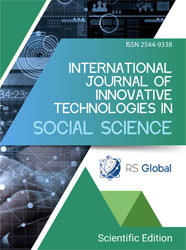ROLE OF PHYSICAL ACTIVITY IN PARKINSON’S DISEASE PREVENTION AND MANAGEMENT – A LITERATURE REVIEW
Abstract
Introduction and purpose: Parkinson’s disease (PD) is a progressive neurodegenerative disorder that is characterized by both motor and non-motor symptoms, such as bradykinesia, tremor, rigidity and instability of the posture. Millions of people suffer from the disease around the world, affecting not only the patients, but also public health systems. Pharmacological interventions exist, although aside from reducing symptoms, no drugs that stop the progression of PD have been developed.
That is why interventions from outside the realm of pharmacology have garnered increased focus of the academics, one of them being physical activity. In recent years, an extensive research was done to prove or disprove a link between exercise and PD’s prevention and management.
What this study aims to do, is to comprehensively gather and review current state of literature in the field of physical activity’s role in prevention and management of Parkinson’s disease.
Material and methods: Our method of research was to scan the databases of academic articles easily accessible on the Internet, such as PubMed, Google Scholar and others. Our team searched for “Parkinson’s disease” together with various terms, such as “physical activity”, “exercise”, “prevention”, “management”, “symptoms” and “treatment”. Following that, the obtained data were manually analysed.
Conclusions: This review, based on quoted research, points to physical activity as a valuable addition to the standard pharmacological treatments, with its potentially beneficial effects all across the PD’s development timeline. From disease prevention and modification, to management of the symptoms, both motor and non-motor alike.
Additional research ought to be conducted in the field to explain the mechanisms and to maximize the effect of the interventions. Nevertheless, contemporary state of knowledge heavily suggests incorporating physical activity into standard treatment strategies for Parkinson’s disease.
References
de Lau LML, Breteler MMB. Epidemiology of Parkinson’s disease. Lancet Neurol. 2006;5(6):525-535. doi:10.1016/S1474-4422(06)70471-9
Tysnes OB, Storstein A. Epidemiology of Parkinson’s disease. J Neural Transm Vienna Austria 1996. 2017;124(8):901-905. doi:10.1007/s00702-017-1686-y
Elbaz A, Carcaillon L, Kab S, Moisan F. Epidemiology of Parkinson’s disease. Rev Neurol (Paris). 2016;172(1):14-26. doi:10.1016/j.neurol.2015.09.012
Su D, Cui Y, He C, et al. Projections for prevalence of Parkinson’s disease and its driving factors in 195 countries and territories to 2050: modelling study of Global Burden of Disease Study 2021. BMJ. 2025;388:e080952. doi:10.1136/bmj-2024-080952
Zahoor I, Shafi A, Haq E. Pharmacological Treatment of Parkinson’s Disease. In: Stoker TB, Greenland JC, eds. Parkinson’s Disease: Pathogenesis and Clinical Aspects. Codon Publications; 2018. Accessed March 26, 2025. http://www.ncbi.nlm.nih.gov/books/NBK536726/
Kalia LV, Lang AE. Parkinson’s disease. The Lancet. 2015;386(9996):896-912. doi:10.1016/S0140-6736(14)61393-3
Fan B, Jabeen R, Bo B, et al. What and How Can Physical Activity Prevention Function on Parkinson’s Disease? Oxid Med Cell Longev. 2020;2020:1-12. doi:10.1155/2020/4293071
Hendriks HFJ. Alcohol and Human Health: What Is the Evidence? Annu Rev Food Sci Technol. 2020;11(1):1-21. doi:10.1146/annurev-food-032519-051827
Nicotine and health. Drug Ther Bull. 2014;52(7):78-81. doi:10.1136/dtb.2014.7.0264
Harirforoosh S, Asghar W, Jamali F. Adverse Effects of Nonsteroidal Antiinflammatory Drugs: An Update of Gastrointestinal, Cardiovascular and Renal Complications. J Pharm Pharm Sci. 2014;16(5):821. doi:10.18433/J3VW2F
Isath A, Koziol KJ, Martinez MW, et al. Exercise and cardiovascular health: A state-of-the-art review. Prog Cardiovasc Dis. 2023;79:44-52. doi:10.1016/j.pcad.2023.04.008
Jagroop D, Dogra S. Physical activity among Canadian adults with obstructive respiratory diseases. Appl Physiol Nutr Metab Physiol Appl Nutr Metab. 2018;43(10):1075-1082. doi:10.1139/apnm-2017-0865
Campaniello D, Corbo MR, Sinigaglia M, et al. How Diet and Physical Activity Modulate Gut Microbiota: Evidence, and Perspectives. Nutrients. 2022;14(12):2456. doi:10.3390/nu14122456
Pupíková M, Rektorová I. Non-pharmacological management of cognitive impairment in Parkinson’s disease. J Neural Transm. 2020;127(5):799-820. doi:10.1007/s00702-019-02113-w
Hayes MT. Parkinson’s Disease and Parkinsonism. Am J Med. 2019;132(7):802-807. doi:10.1016/j.amjmed.2019.03.001
Anglade P, Vyas S, Javoy-Agid F, et al. Apoptosis and autophagy in nigral neurons of patients with Parkinson’s disease. Histol Histopathol. 1997;12(1):25-31.
Schapira AH, Jenner P. Etiology and pathogenesis of Parkinson’s disease. Mov Disord. 2011;26(6):1049-1055. doi:10.1002/mds.23732
Reich SG, Savitt JM. Parkinson’s Disease. Med Clin North Am. 2019;103(2):337-350. doi:10.1016/j.mcna.2018.10.014
Sveinbjornsdottir S. The clinical symptoms of Parkinson’s disease. J Neurochem. 2016;139(S1):318-324. doi:10.1111/jnc.13691
Pfeiffer RF. Autonomic Dysfunction in Parkinson’s Disease. Neurotherapeutics. 2020;17(4):1464-1479. doi:10.1007/s13311-020-00897-4
Aarsland D, Kurz MW. The epidemiology of dementia associated with Parkinson disease. J Neurol Sci. 2010;289(1-2):18-22. doi:10.1016/j.jns.2009.08.034
Haddad F, Sawalha M, Khawaja Y, Najjar A, Karaman R. Dopamine and Levodopa Prodrugs for the Treatment of Parkinson’s Disease. Molecules. 2017;23(1):40. doi:10.3390/molecules23010040
Fahn S. The history of dopamine and levodopa in the treatment of Parkinson’s disease: Dopamine and Levodopa in the Treatment of PD. Mov Disord. 2008;23(S3):S497-S508. doi:10.1002/mds.22028
Wirdefeldt K, Odin P, Nyholm D. Levodopa–Carbidopa Intestinal Gel in Patients with Parkinson’s Disease: A Systematic Review. CNS Drugs. 2016;30(5):381-404. doi:10.1007/s40263-016-0336-5
Hoy SM. Levodopa/Carbidopa Enteral Suspension: A Review in Advanced Parkinson’s Disease. Drugs. 2019;79(15):1709-1718. doi:10.1007/s40265-019-01201-1
Tan YY, Jenner P, Chen SD. Monoamine Oxidase-B Inhibitors for the Treatment of Parkinson’s Disease: Past, Present, and Future. J Park Dis. 12(2):477-493. doi:10.3233/JPD-212976
Bidesi NSR, Vang Andersen I, Windhorst AD, Shalgunov V, Herth MM. The role of neuroimaging in Parkinson’s disease. J Neurochem. 2021;159(4):660-689. doi:10.1111/jnc.15516
Elsworth JD. Parkinson’s disease treatment: past, present, and future. J Neural Transm Vienna Austria 1996. 2020;127(5):785-791. doi:10.1007/s00702-020-02167-1
Ye H, Robak LA, Yu M, Cykowski M, Shulman JM. Genetics and Pathogenesis of Parkinson’s Syndrome. Annu Rev Pathol. 2023;18:95-121. doi:10.1146/annurev-pathmechdis-031521-034145
Gandini S, Botteri E, Iodice S, et al. Tobacco smoking and cancer: a meta-analysis. Int J Cancer. 2008;122(1):155-164. doi:10.1002/ijc.23033
Ascherio A, Schwarzschild MA. The epidemiology of Parkinson’s disease: risk factors and prevention. Lancet Neurol. 2016;15(12):1257-1272. doi:10.1016/S1474-4422(16)30230-7
Murray A, Traylor J. Caffeine Toxicity. In: StatPearls. StatPearls Publishing; 2025. Accessed July 27, 2025. http://www.ncbi.nlm.nih.gov/books/NBK532910/
Warburton DER, Bredin SSD. Health benefits of physical activity: a systematic review of current systematic reviews. Curr Opin Cardiol. 2017;32(5):541-556. doi:10.1097/HCO.0000000000000437
Fang X, Han D, Cheng Q, et al. Association of Levels of Physical Activity With Risk of Parkinson Disease: A Systematic Review and Meta-analysis. JAMA Netw Open. 2018;1(5):e182421. doi:10.1001/jamanetworkopen.2018.2421
Langeskov-Christensen M, Franzén E, Grøndahl Hvid L, Dalgas U. Exercise as medicine in Parkinson’s disease. J Neurol Neurosurg Psychiatry. 2024;95(11):1077-1088. doi:10.1136/jnnp-2023-332974
Portugal B, Artaud F, Degaey I, et al. Association of Physical Activity and Parkinson Disease in Women. Neurology. 2023;101(4):e386-e398. doi:10.1212/WNL.0000000000207424
Alberts JL, Rosenfeldt AB. The Universal Prescription for Parkinson’s Disease: Exercise. J Park Dis. 10(Suppl 1):S21-S27. doi:10.3233/JPD-202100
Wang Z, Myers KG, Guo Y, et al. Functional reorganization of motor and limbic circuits after exercise training in a rat model of bilateral parkinsonism. PloS One. 2013;8(11):e80058. doi:10.1371/journal.pone.0080058
Endurance exercise training promotes angiogenesis in the brain of chronic/progressive mouse model of Parkinson’s Disease - Muhammed Al-Jarrah, Mohammad Jamous, Khalid Al Zailaey, Salameh O. Bweir, 2010. Accessed April 15, 2025. https://journals.sagepub.com/doi/10.3233/NRE-2010-0574
Globus M, Mildworf B, Melamed E. Cerebral blood flow and cognitive impairment in Parkinson’s disease. Neurology. 1985;35(8):1135-1139. doi:10.1212/wnl.35.8.1135
Johansson H, Hagströmer M, Grooten WJA, Franzén E. Exercise-Induced Neuroplasticity in Parkinson’s Disease: A Metasynthesis of the Literature. Neural Plast. 2020;2020:8961493. doi:10.1155/2020/8961493
Radder DLM, Lígia Silva de Lima A, Domingos J, et al. Physiotherapy in Parkinson’s Disease: A Meta-Analysis of Present Treatment Modalities. Neurorehabil Neural Repair. 2020;34(10):871-880. doi:10.1177/1545968320952799
da Silva FC, Iop R da R, de Oliveira LC, et al. Effects of physical exercise programs on cognitive function in Parkinson’s disease patients: A systematic review of randomized controlled trials of the last 10 years. PloS One. 2018;13(2):e0193113. doi:10.1371/journal.pone.0193113
Kwok JYY, Kwan JCY, Auyeung M, et al. Effects of Mindfulness Yoga vs Stretching and Resistance Training Exercises on Anxiety and Depression for People With Parkinson Disease: A Randomized Clinical Trial. JAMA Neurol. 2019;76(7):755-763. doi:10.1001/jamaneurol.2019.0534
Amara AW, Memon AA. Effects of Exercise on Non-Motor Symptoms in Parkinson’s Disease. Clin Ther. 2018;40(1):8-15. doi:10.1016/j.clinthera.2017.11.004
Ellis TD, Colón-Semenza C, DeAngelis TR, et al. Evidence for Early and Regular Physical Therapy and Exercise in Parkinson’s Disease. Semin Neurol. 2021;41(2):189-205. doi:10.1055/s-0041-1725133
Views:
68
Downloads:
24
Copyright (c) 2025 Jakub Zajączkowski, Adrianna Zajączkowska, Kacper Stępniak, Jan Wilk, Radosław Kuźma, Karolina Marrodán-Wojtczak, Aleksandra Kujawa, Paulina Krzeszowska, Karolina Krochmal, Jakub Jarmołowicz

This work is licensed under a Creative Commons Attribution 4.0 International License.
All articles are published in open-access and licensed under a Creative Commons Attribution 4.0 International License (CC BY 4.0). Hence, authors retain copyright to the content of the articles.
CC BY 4.0 License allows content to be copied, adapted, displayed, distributed, re-published or otherwise re-used for any purpose including for adaptation and commercial use provided the content is attributed.















